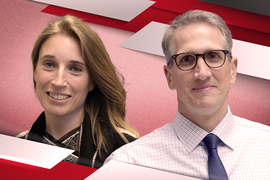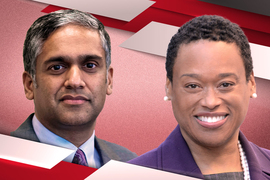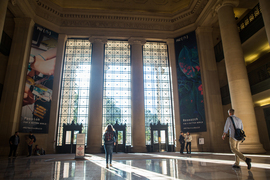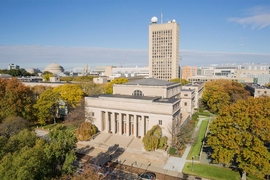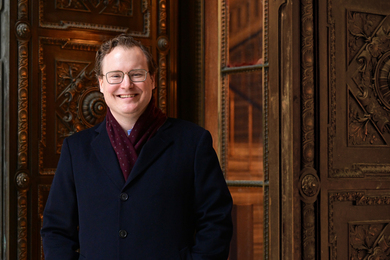This is part three in a series of interviews with co-chairs of Task Force 2021 and Beyond workstreams. Parts one and two were published in recent weeks.
MIT’s Task Force 2021 and Beyond has been at work for nine months, charged by President Rafael Reif with exploring “how MIT might invent a thriving new future” in a post-Covid world. The effort’s Administrative Workstream, whose charge included looking at the future of working at MIT, was co-chaired by Joe Higgins, vice president for campus services and stewardship, and Krystyn Van Vliet, associate provost and Michael and Sonja Koerner Professor of Materials Science and Engineering.
Higgins and Van Vliet spoke with MIT News about the recent societal changes that are likeliest to impact how employees work at MIT, the themes that arose in their group’s conversations, and the changes that might arise if some of the working group’s proposals are adopted.
Q: What changes — due to the events of this past year — do you think will have the most significant impact on working at MIT?
Van Vliet: We’ve learned so much from our unanticipated pilot with remote working — which was, of course, imposed upon us last spring by the arrival of Covid-19.
We learned that many members of the MIT community can be just as productive, if not more so, while working from home or other locations. Of course, we also learned that thousands of us — including Joe and me — cannot carry out our MIT roles without accessing campus regularly, even if not daily. And we learned new things about ourselves and our MIT teams when we had no choice but to adapt where and how we did our work, both alone and together.
As our remote work has stretched on over many months, we’ve all come to understand what we now miss dearly about our in-person campus community. But we’ve also found ourselves grateful to have a respite from less pleasant aspects of our working lives, such as challenging Boston-area commutes.
Higgins: Along the same lines, the pandemic created a forced experiment in MIT’s operations. We learned what our current technology systems and policies can flexibly support, and where improvements could be rapidly applied to support our academic, research, and administrative functions. A rapid evolution in our building access protocols (including the creation of Covid Pass) and digital workflow management for design and construction projects are some areas that come to mind.
Q: What were themes that emerged in your group’s discussions, and in the ideas that your group put forward?
Higgins: It’s clear that the pandemic has caused our working group to think deeply about where and how we perform our work: Which activities are best performed on campus? Which can be done as well, or possibly even better or more sustainably, remotely? The group considered these questions as we look ahead to the time when more of us will be able to return to campus. As we consider the Institute’s post-pandemic stance, there is a keen desire to balance the flexibility and sustainability afforded by a range of hybrid work models — allowing us to work where we are most productive, and also maintain our sense of community that’s best created and fostered through in-person interactions.
To enable more flexible work on a sustained basis, we’ll need to continue to evolve our policies, practices, systems, platforms, and tools to support our research, education, and administrative enterprises.
Van Vliet: Consistent with a more flexible work environment, we’ll need to consider how changing work practices and technologies will change demand for the myriad types of spaces we have on campus: classrooms, research spaces (including both labs and offices), community spaces, dining spaces, outdoor spaces, residential facilities, and flexible work spaces for students, staff, and faculty.
As we think of how MIT can become a stronger Institute and support all the individuals who are part of carrying out MIT’s leading-edge research, teaching, and learning, we will also need to discuss and plan together how to use these campus spaces collaboratively.
On any urban campus, including MIT’s, space is both a real constraint and an exciting opportunity to renew and reinvent. And as the Task Force working groups emphasized to us, now is the time to think about how we better use this campus resource to align with MIT’s values, commitments to our community and the world, and central mission of impactful research and education.
Another theme woven throughout our group’s conversations was the need to enhance employee development. That includes fostering skills development and offering commensurate training, mentoring, and support to help our valued employees map out their career pathways at MIT.
A final theme that emerged in our team’s discussions — prompted by the sudden and sometimes jarring shifts that we have all experienced over the past year — is the need for agile, cross-functional teams that can help us in the accelerated development of systems and tools to support all of our work at the Institute. The teams enabling MIT’s adapted operations during the height of the pandemic were unstintingly dedicated to the rapid solutions needed. We can learn from that, of course, but aspire to a more sustainable approach to continued innovation of our work practices.
Q: If some of your group’s key ideas are implemented, how would MIT be different for its employees in the years to come?
Higgins: It seems likely that both working and learning at MIT will remain more diffuse even once physical distancing is no longer absolutely necessary.
There will always be an important on-campus element: Certain tasks and activities require in-person collaboration. At the same time, a more flexible work environment will help us create a campus environment where our precious space is focused on our highest-value activities.
This may mean that in the coming years we will see more shared and flexible spaces on campus, and possibly the emergence of MIT community worksites outside of the immediate Cambridge campus.
Van Vliet: Looking forward, our group also feels that MIT will need to develop a more robust onboarding program for new employees. All staff must have the tools, systems, and resources to ensure their personal and professional development, creating new support for their growth and helping them build career ladders. All faculty, who work closely with many research and administrative staffers, can also benefit from improved onboarding, tools to manage our broad responsibilities, and greater awareness of and appreciation for staff roles and career trajectories. This is all part of being “One MIT,” which our working groups identified as important to building diverse, talented, and dedicated teams — no matter where we do our daily work.
We have also recommended a new agile project management team to support the implementation of MIT priority projects for administrative workflows. Ultimately, this work will help foster a more modern, data-driven infrastructure for MIT’s work on and off campus.
